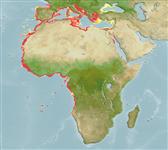Élasmobranches (requins et raies) (sharks and rays) >
Torpediniformes (Electric rays) >
Torpedinidae (Electric rays)
Etymology: Torpedo: Latin, torpere = be sluggish (Ref. 45335).
More on author: Linnaeus.
Environment: milieu / climate zone / depth range / distribution range
Écologie
marin démersal; profondeur 2 - 400 m (Ref. 4430), usually ? - 70 m (Ref. 27000). Deep-water; 48°N - 18°S, 19°W - 38°E (Ref. 114953)
Eastern Atlantic: southern Bay of Biscay and throughout the Mediterranean to Angola. Most common in tropical waters.
Taille / Poids / Âge
Maturity: Lm ? range ? - ? cm
Max length : 60.0 cm TL mâle / non sexé; (Ref. 13417); 41.0 cm TL (female); common length : 30.0 cm TL mâle / non sexé; (Ref. 13417); common length :39 cm TL (female)
Found on soft bottoms, usually inshore but occasionally deeper. Feeds on small fishes and also benthic invertebrates. Ovoviviparous, with 3-21 in a litter (Ref. 12951, Ref. 114953). Size at birth 9 cm (Ref. 12951). Capable of inflicting a severe shock of up to 200 volts.
Life cycle and mating behavior
Maturité | Reproduction | Frai | Œufs | Fécondité | Larves
Exhibit ovoviparity (aplacental viviparity), with embryos feeding initially on yolk, then receiving additional nourishment from the mother by indirect absorption of uterine fluid enriched with mucus, fat or protein through specialised structures (Ref. 50449).
Bauchot, M.-L., 1987. Raies et autres batoides. p. 845-886. In W. Fischer, M.L. Bauchot and M. Schneider (eds.) Fiches FAO d'identificationpour les besoins de la pêche. (rev. 1). Mèditerranée et mer Noire. Zone de pêche 37. Vol. II. Commission des Communautés Européennes and FAO, Rome. (Ref. 3261)
Statut dans la liste rouge de l'IUCN (Ref. 130435: Version 2024-2)
Utilisations par l'homme
Pêcheries: sans intérêt; Aquarium: Aquariums publics
Outils
Articles particuliers
Télécharger en XML
Sources Internet
Estimates based on models
Preferred temperature (Ref.
123201): 13 - 20.9, mean 15.6 °C (based on 78 cells).
Phylogenetic diversity index (Ref.
82804): PD
50 = 0.5005 [Uniqueness, from 0.5 = low to 2.0 = high].
Bayesian length-weight: a=0.01549 (0.01185 - 0.02025), b=2.95 (2.87 - 3.03), in cm total length, based on LWR estimates for this species (Ref.
93245).
Niveau trophique (Ref.
69278): 4.5 ±0.0 se; based on diet studies.
Generation time: 10.0 ( na - na) years. Estimated as median ln(3)/K based on 1
growth studies.
Résilience (Ref.
120179): Faible, temps minimum de doublement de population : 4,5 à 14 années (K=0.11).
Fishing Vulnerability (Ref.
59153): High to very high vulnerability (65 of 100).
Nutrients (Ref.
124155): Calcium = 9.24 [1.57, 48.04] mg/100g; Iron = 0.362 [0.085, 1.136] mg/100g; Protein = 17.3 [12.8, 20.6] %; Omega3 = 0.419 [0.157, 0.972] g/100g; Selenium = 9.34 [2.94, 27.66] μg/100g; VitaminA = 20 [4, 94] μg/100g; Zinc = 0.311 [0.151, 0.581] mg/100g (wet weight);
